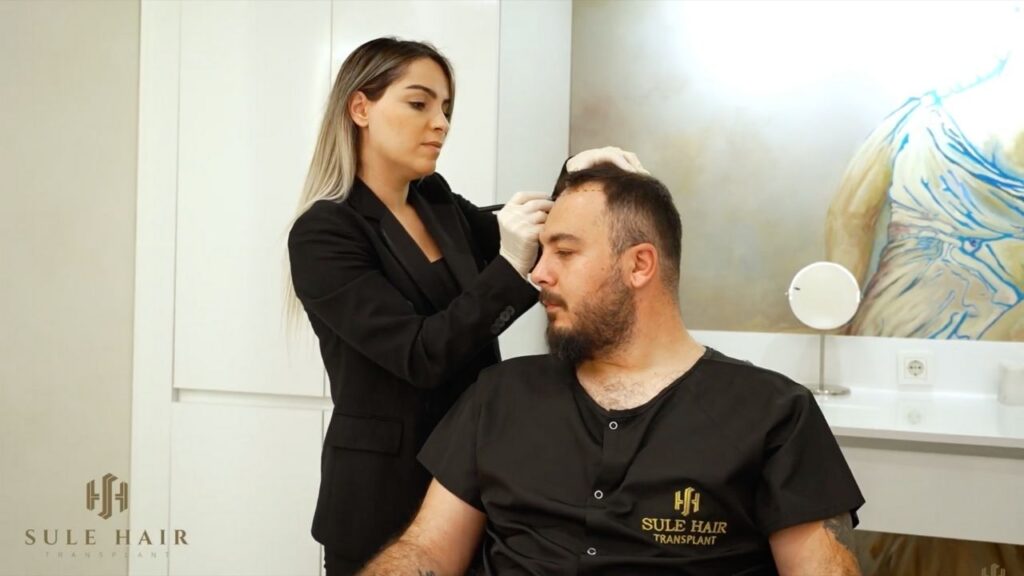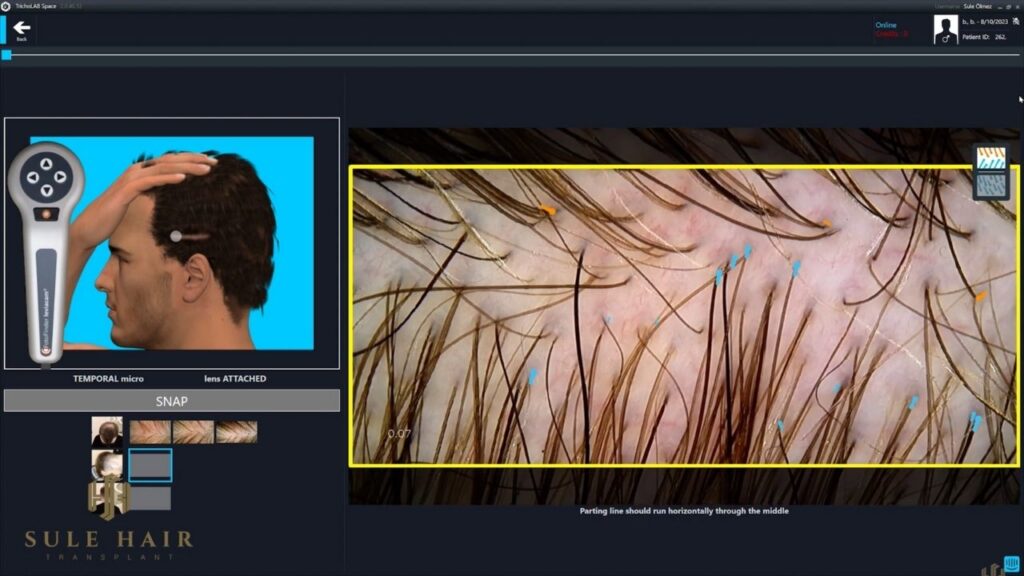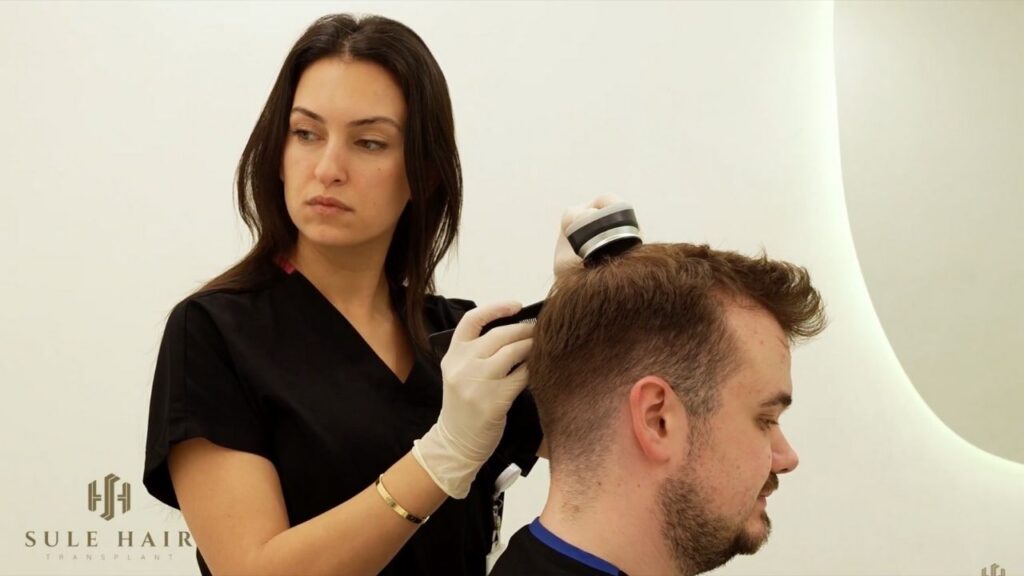Hair transplant surgery, a procedure used to treat hair loss, involves the transfer of hair-bearing skin from one part of the scalp to bald or thinning areas. If you’re considering a hair transplant, you may wonder, “How many grafts do I need?” Determining the number of hair transplant grafts required is crucial for achieving optimal results in hairline restoration.

At Sule Hair Clinic, we address one of the most common inquiries regarding hair transplantation: “How many grafts for the hairline?” We utilize the latest technology in the field to provide accurate answers. Utilizing cutting-edge hair transplant technology, we employ software and machinery to calculate grafts.
Transplanner: Advanced Software for Hair Transplant Evaluation and Planning
The software known as the Transplanner is the analysis machine that I would like to present to you. Allow me to take you on a tour of the machine and the software, and I will explain why each of these functions is necessary. As an example for today, let’s look at myself. We will start taking photographs step by step, catching each side of my head in great detail as I put my head on the machine, positioning my chin here and my forehead there.
The professional program analyzes the hair’s properties and the vertex, frontal, temporal, and occipital regions of the head. It also gives hair surgeons information regarding the number of follicular units (grafts) required to obtain the desired result in the target area.

Now, let’s go deeper into evaluating both my potential transplant and donor areas to evaluate the quality of my grafts and whether or not they are dense enough. This thorough evaluation will be very helpful to our medical professionals as they prepare every aspect of my upcoming hair transplant procedure in conjunction with the analysis that the Transplanner program provides.
To get a precise estimate of the size of my head, which is essential for planning, we will begin by measuring the circumference of my head. After that, the analysis machine examines all of my graft groups and donor attributes, highlighting areas of strength and locations where hair loss is likely to occur. In addition to providing a count of grafts per square centimetre, it offers a detailed classification system for single, double, and triple hair transplants. The average density per square centimetre is also displayed on the screen.
We will mark certain spots on my skull to determine the extent of the places on my head that require transplanting. The machine helps determine the required quantity of single, double, and triple grafts for the transplanted locations and the regions intended to be donated.
To guarantee an even distribution, we will select donor locations on both the back and the sides. Within each donor region, the system assists in determining the maximum number of grafts that can be safely extracted.

Following the completion of the study, the machine performs an accurate calculation to determine the total number of grafts required for the crown area that I have chosen, which arrives at 3,531 grafts.
After everything is finished, we will save the file as a PDF and give a printed copy to the patient, which is, in this case, me today. Thanks to this all-encompassing plan, every facet of the operation will be carried out securely and uncomplicatedly.
Understanding Hair Grafts and How They Work
Hair transplant surgery involves moving hair-bearing skin from one part of the scalp to bald or thinning areas. Technicians from the donor site tissue prepare the grafts, which can be of different configurations, such as:
- Larger grafts with multiple follicles
- “Micro” grafts with two or three follicles
- Single-follicle grafts
- Follicular units with naturally occurring clusters of three or more follicles
The grafts are categorized by size and shape:
| Graft Type | Number of Hairs |
|---|---|
| Punch Grafts | 10-15 |
| Mini-Grafts | 2-4 |
| Micro-Grafts | 1-2 |
| Slit Grafts | 4-10 |
| Strip Grafts | 30-40 |
The scalp skin is cut into small incisions, and the grafts are inserted into those wounds. To guarantee a blood supply and organic hair development, the incisions must be of the appropriate depth, angle, size, and orientation. Needles, microscopic slits, punch holes, or laser-made holes are some of the possible types of apertures that can be formed using a variety of equipment.

Two main methods for hair transplantation are follicular unit strip surgery (FUSS) and follicular unit extraction (FUE):
- FUSS: The surgeon removes a 6- to 10-inch strip of skin from the back of the head, divides it into 500 to 2,000 tiny grafts, and transplants the grafts to the bald area.
- FUE: The surgeon removes hair follicles one by one from the back of the scalp, and the area heals with small dots covered by existing hair.
The number of grafts transplanted during each session varies from person to person. Still, on average, approximately fifty in the case of large plugs and up to seven hundred in the case of mini-grafts or micro-grafts are transplanted during each session. While it may take up to two years to see the ultimate effect of a full transplant series, multiple surgical procedures may be necessary to attain a suitable level of fullness.
Calculating Your Hair Graft Requirement
One of the most important steps during planning is determining the needed number of hair grafts for a successful hair transplant treatment. To determine the graft count, several parameters are considered. These considerations include the degree of hair loss, the pattern of balding, the availability of the donor area, and the features of the individual’s hair.
When attempting to predict the number of grafts necessary based on the stage of hair loss, the Norwood scale, which has a range of one to seven, is frequently utilized. To determine the estimated graft count, multiply the Norwood scale stage by one thousand to five hundred grafts. However, specific factors can influence the number of grafts required, such as the contrast between the skin and the hair, the hair’s thickness, and the hair’s curliness.
| Factor | Effect on Graft Count |
|---|---|
| High skin to hair color contrast | Requires more grafts for coverage |
| Thicker hair | Requires fewer grafts |
| Curly hair | Covers a wider surface area, requiring fewer grafts for coverage |
During the initial consultation, the hair transplant surgeon assesses the grade of baldness to determine the final confirmed count of the hair grafts required. Sule Hair Clinic provides a hair graft calculator that estimates the number of grafts and hairs required for a successful FUE hair transplant, considering factors such as age, gender, hair type, and colour, and the areas affected by hair loss.
The Impact of Hair Loss Stage on Graft Numbers
The stage of hair loss is a critical factor to consider when determining the needed quantity of grafts for a successful hair transplant. The Norwood scale, which ranges from 1 to 7, is frequently utilized to determine the level of hair loss and estimate the number of grafts required for various scalp locations.
| Scalp Region | Graft Range |
|---|---|
| Hairline and Temples | 500 – 1,800 |
| Mid-Scalp | 500 – 1,500 |
| Crown | 1,000 – 2,500 |
A typical 4,000 grafts are necessary to reach the desired density level in the scalp’s crown, mid-scalp, and front regions. As the stage of hair loss continues, the number of grafts required to treat the condition simultaneously increases.
It should be brought to your attention that, to achieve a desirable level of fullness, it may be necessary to undergo multiple surgical procedures. However, the final result of a whole transplant series might not be obvious for up to two years after the procedure has been completed.
Safe Donor Area and Its Importance
The safe donor area, often situated at the back and sides of the scalp, is a significant component in determining the total number of grafts available for transplantation. This region is genetically resistant to hair loss, which makes it a good source for harvesting hair follicles. Several parameters, including hair density, hair quality, and scalp laxity, might influence the availability of grafts in the donor area. These characteristics vary from person to person.
During the consultation phase, the hair transplant surgeon will evaluate the safe donor location to estimate the number of grafts that can be retrieved without changing the appearance of the donor site. This evaluation can accurately determine the maximum number of grafts transplanted in a single session and the potential for future transplant procedures.
Additionally, it is essential to remember that the safe donor area does not consist solely of the scalp. Harvesting hair follicles from other body regions, such as the beard, chest, or legs, is possible in some circumstances, such as when eyelash transplantation is used. The process is normally carried out in the physician’s office and can take anywhere from four to eight hours to complete, depending on the number of grafts that are the subject of the transplant.
Conclusion and Next Steps
Hair transplantation is a surgery that can completely transform a person’s life, particularly for those looking to restore their hairline and reclaim their confidence. Individuals can make educated decisions regarding their hair restoration journey if they have a fundamental grasp of hair grafts, calculate graft requirements depending on the hair loss stage, and consider the safe donor area. Thanks to the development of new surgical procedures and the knowledge of professional surgeons, it is now easier than ever to get natural results.
The Transplanner program is crucial in ensuring patients have the best possible results by methodically planning and carrying out hair transplant treatments. One of the most important tools for ensuring a safe transplant and getting the best potential outcomes is the Transplanner, which provides recommendations for the optimal density for harvesting and inserting grafts.
It is crucial for those contemplating hair transplantation to visit a qualified clinic to discuss their requirements and objectives. Sule Hair Clinic provides individualized consultations and cutting-edge hair restoration services, catering to each client’s needs. It is important to remember that the first step toward achieving a broader and more youthful hairline is to take the initiative to learn about the various options available to you and to collaborate with professionals with vast knowledge to get the most excellent results.
FAQs
Q: What is the typical range of hair grafts needed for hairline restoration? A: To create a more natural-looking hairline, the typical range is between 500 and 1,800 hair grafts, particularly at the front of the head.
Q: How much scalp area can 2,000 hair grafts cover? A: With each graft potentially containing up to four hair follicles, 2,000 hair grafts can provide between 4,000 and 8,000 hairs. This amount is generally sufficient to cover one-third to one-half of a scalp, though this varies based on the donor’s hair quality and the individual’s head size.
Q: What scalp area do 4,000 grafts typically cover in a hair transplant? A: On average, a hair transplant procedure involving 4,000 grafts can cover the front, middle, and crown (or vertex) areas of the scalp, providing decent hair density.
Q: For which stages of hair loss are 6,000 grafts enough, and what coverage can it achieve? A: A total of 6,000 grafts is usually adequate for restoring the front hairline and crown in individuals at Norwood 2-4 stages of hair loss. For those at the Norwood 5 stage, the same number of grafts would likely result in only sparse or partial coverage of the entire hair loss area.





